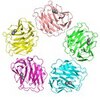219401 Sigma-AldrichCathepsin D, Human Liver
Cathepsin D, Human Liver, CAS 9025-26-7, is a purified native cathepsin D from human liver. Overexpression of cathepsin D in is associated with higher risk of cancer relapse and metastasis.
More>> Cathepsin D, Human Liver, CAS 9025-26-7, is a purified native cathepsin D from human liver. Overexpression of cathepsin D in is associated with higher risk of cancer relapse and metastasis. Less<<Recommended Products
Overview
| Replacement Information |
|---|
Products
| Catalog Number | Packaging | Qty/Pack | |
|---|---|---|---|
| 219401-15U | Plastic ampoule | 15 u | |
| 219401-30U | Plastic ampoule | 30 u |
| Product Information | |
|---|---|
| CAS number | 9025-26-7 |
| Unit of Definition | One unit is defined as the amount of enzyme that will digest acid-denatured hemoglobin in 60 min, at 37°C, pH 3.3, releasing peptides soluble in 10% TCA, as measured by an increase in absorbance of 1.0 at 280 nm |
| EC number | 3.4.23.5 |
| Form | Lyophilized |
| Formulation | Lyophilized from 2 mM sodium phosphate buffer, pH 6.5. |
| Quality Level | MQ100 |
| Applications |
|---|
| Physicochemical Information |
|---|
| Dimensions |
|---|
| Materials Information |
|---|
| Toxicological Information |
|---|
| Safety Information according to GHS |
|---|
| Safety Information |
|---|
| Product Usage Statements |
|---|
| Packaging Information |
|---|
| Transport Information |
|---|
| Supplemental Information |
|---|
| Specifications |
|---|
| Global Trade Item Number | |
|---|---|
| Catalog Number | GTIN |
| 219401-15U | 04055977201710 |
| 219401-30U | 04055977201727 |
Documentation
Cathepsin D, Human Liver Certificates of Analysis
| Title | Lot Number |
|---|---|
| 219401 |
References
| Reference overview |
|---|
| Berchem, G., et al. 2002. Oncogene 21, 5951. Barbi, G.P., et al. 1994. Oncology 51, 329. Krishnan, V., et al. 1994. J. Biol. Chem. 269, 15912. Touitou, I., et al. 1994. Eur. J. Cancer 30A, 390. Rijnboutt, S., et al. 1991. J. Biol. Chem. 266, 23586. Johnson, G.V., et al. 1991. J. Neurochem. 57, 1577. Erickson, A. 1989. J. Cell. Biochem. 40, 31. |
Brochure
| Title |
|---|
| Cathepsins and Related Products Technical Bulletin |












